Online Courses
The 14 Best Alternatives to Thinkific in 2025
Looking for an alternative to Thinkific? This is the guide for you.
Author
Mighty Team
Last Updated
July 31, 2025

Thinkific is software for creating online courses, and selling those courses to an audience. It can be used as a self-hosted course platform or it can be integrated with an existing WordPress site.
Thinkific is strong for pre-recorded courses. But whether you're about to launch your first online course or you've outgrown it, the Thinkific alternatives in this article will help you understand your options.
We'll cover:
What Thinkific is
What Thinkific does well
The cons of Thinkific
14 Thinkific alternatives
Try the best Thinkific alternative for courses and community free!
14 Thinkific alternatives (Quick Chart)
Here's a quick guide to the best Thinkific alternatives on the market. Click on the options for a deeper dive. There's a full comparison below.
Best Features | Use For | Cost | |
|---|---|---|---|
Live & Async Courses, Run Alongside Memberships, Events & Livestreams | Building Courses w/ Community & Live Events | $109/mo | |
Branded Course Apps, Strategy & Support, Proactive Updates | Custom Mobile Apps for Courses | Learn More Here | |
Pre-Made Funnels, Email Marketing, LMS for Pre-Recorded Courses | Marketing Automations for Async Courses | $149/mo | |
Course Website, Good Evaluation Tools | Hosted Courses & Website Pages | $59/mo + 5% Fees | |
Marketplace w/ Millions of Students, Easy Course-Building | Exposure to New Students | Udemy Takes Up to 67% of Revenue | |
Drag & Drop Websites, ECommerce & Course Tools | Website Builder + Products & LMS | $39/mo + 5% Fees | |
WordPress LMS | Async Courses on WordPress | $199/yr | |
Creator-Focused Courses, Marketplace w/ Millions of Students | Course Marketplace | Partial Revenue Payouts to Creators | |
White-Label LMS & Virtual Classrooms | Branded Courses & Classrooms | Varies | |
Cohort-Based Learning, Live Teaching, Hand Picked Instructors | Live, Interactive Cohorts | Revenue Share | |
Courses & Community Tools | Courses w/ Community | $99/mo | |
Subscriptions, Membership Sales, WordPress Integration | Membership & Subscription Revenue | Free + 10% Transaction Fee | |
Career Skills, Professional Courses, Certifications | Skill Building & Career Growth | Payments Vary | |
Large Platform, Video Hosting, Ad Revenue Options | Free Learning & Video Content | Free |
What is Thinkific?
Thinkific is an online course platform that lets you build and host an online course; it includes features for elearning authoring and learning management.
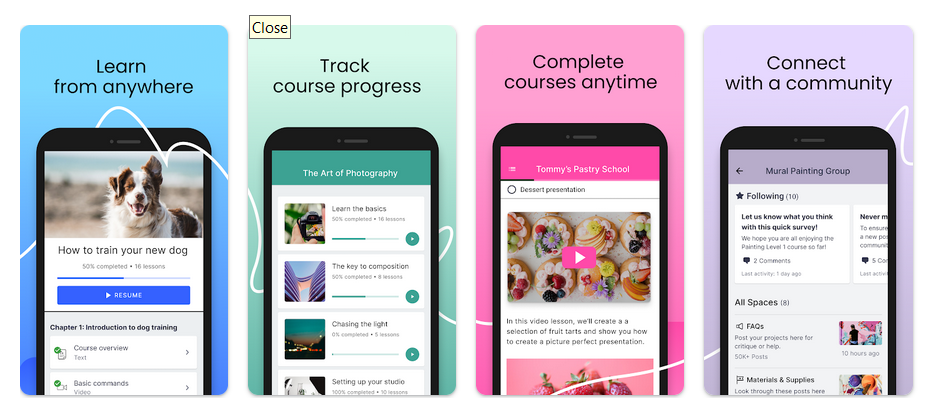
What Thinkific does well
When Thinkific launched in 2012, it was a “state-of-the-art” online course platform focused solely on content. At the time, it was a great option for monetizing knowledge in a marketplace that didn't have many.
Its initial features were:
Adding and hosting course content
Sales and checkout options
Landing pages and a course "website"
The standard was pre-recorded (asynchronous) courses, and this is still what Thinkific does best. Here are its best features.
Drag-and-drop course builder
Import tools & dripped content
Quizzes, tests, credits, and certificates
Course homepages and landing pages
Basic native email
Marketing and analytics
Thinkific offers a basic free plan too, which can be good for creators testing out their first course.
Disadvantages of Thinkific
Here are some of the reasons course creators are leaving Thinkific.
It's missing engagement tools: Synchronous courses are growing in popularity, boosting the need for livestreaming, chat and messaging, and better member engagement tools, and Thinkific hasn't kept up.
Digital products based on asynchronous infrastructure: Because the original design was asynchronous courses, most of Thinkific's products still work on an LMS (e.g. programs, digital downloads). It's weak for things like masterminds, live events, livestreams, and course communities.
Weak community and membership features: The online community feature on Thinkific is really just a simple forum. It's not in line with modern community platforms.
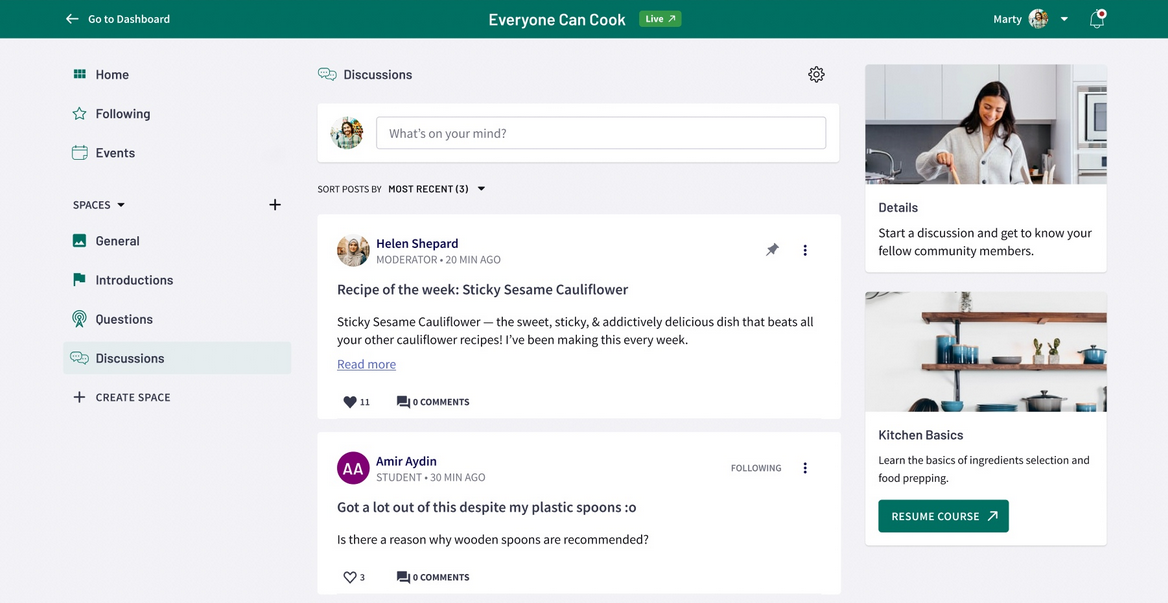
No native livestreaming: going live or teaching cohort courses is only possible with third-party platforms.
Poorly-rated apps: The online course apps were only released in 2021. With a 2.6 star review in the Google Play Store and a 2.2 in the App Store, the apps are notorious for not hosting content, crashing frequently, and bad UX.

What to look for in a Thinkific alternative
More teaching options: More ways to deliver and charge for course content, including more flexible options for livestreaming (natively) and cohort courses.
More community and membership options: Powerful community features to let you tap into member-led growth and the joy of a learning community is a MUST for a Thinkific alternative.
More engagement options: Look for an alternative that gives you more ways to engage members, think virtual events, the options to build programs, masterminds, group coaching, etc.
Better apps: With Thinkific's low-rated apps, ideally an alternative would have better apps for your students (not every option on this list does--we've marked them).
Branded apps: If you want to release your course under your own app in the App Store and Google Play Store, the right alternative to Thinkific could do that for you.
Easier management: Look for options that simplify course-building, marketing & sales funnels, community, etc. Some of these platforms are using AI to make courses easier, or automations to let you focus on the stuff that matters.
Alternatives to Thinkific
1. Mighty Networks
Best Thinkific alternative for courses and community
Mighty Networks brings together courses, community, content, and commerce, with a powerhouse set of features that makes it the best Thinkific alternative.
Mighty includes an intuitive course platform; you can build out a traditional pre-recorded course, adding in lessons and modules, video, and text like Thinkific.
But Mighty isn't just for pre-recorded courses. It's also got great live-teaching capabilities with livestreaming and events features. So you've got three options to deliver your course:
A content-only online course. Build a pre-recorded course Space that feels like a traditional online course.
An online course with a dedicated course community. Connect a pre-recorded course with a ton of community and engagement features to bring your course to life.
A course delivered “live.” The last option is the most interesting one, especially for instructors creating their first online course. A live course lets you build deep connections with members, pivoting and growing as you teach, AND testing the waters with a pre-sale.

Here's where Mighty beats Thinkific:
Versatile course Spaces: Customize the features of ANY course Space to link your course with events, discussions, assignments, chat, or a dedicated course community Space. You have total control over the features you include with your course.
G2's top-ranked community platform: Other course platforms are rushing to add community features, but online community building has never been an afterthought for Mighty. Community permeates everything we build, giving you engagement like nothing else. Activity feeds, elevated discussion forums, chat & messaging, live events, live streaming, Q&As, polls & questions, and even a built-in community assistant (Mighty Co-Host™).
Software designed to connect members: REAL community comes from members connecting to each other. Mighty uses a dynamic people explorer to help members find each other. AI can help them build profiles, show similarities with other members, and even start a conversation.
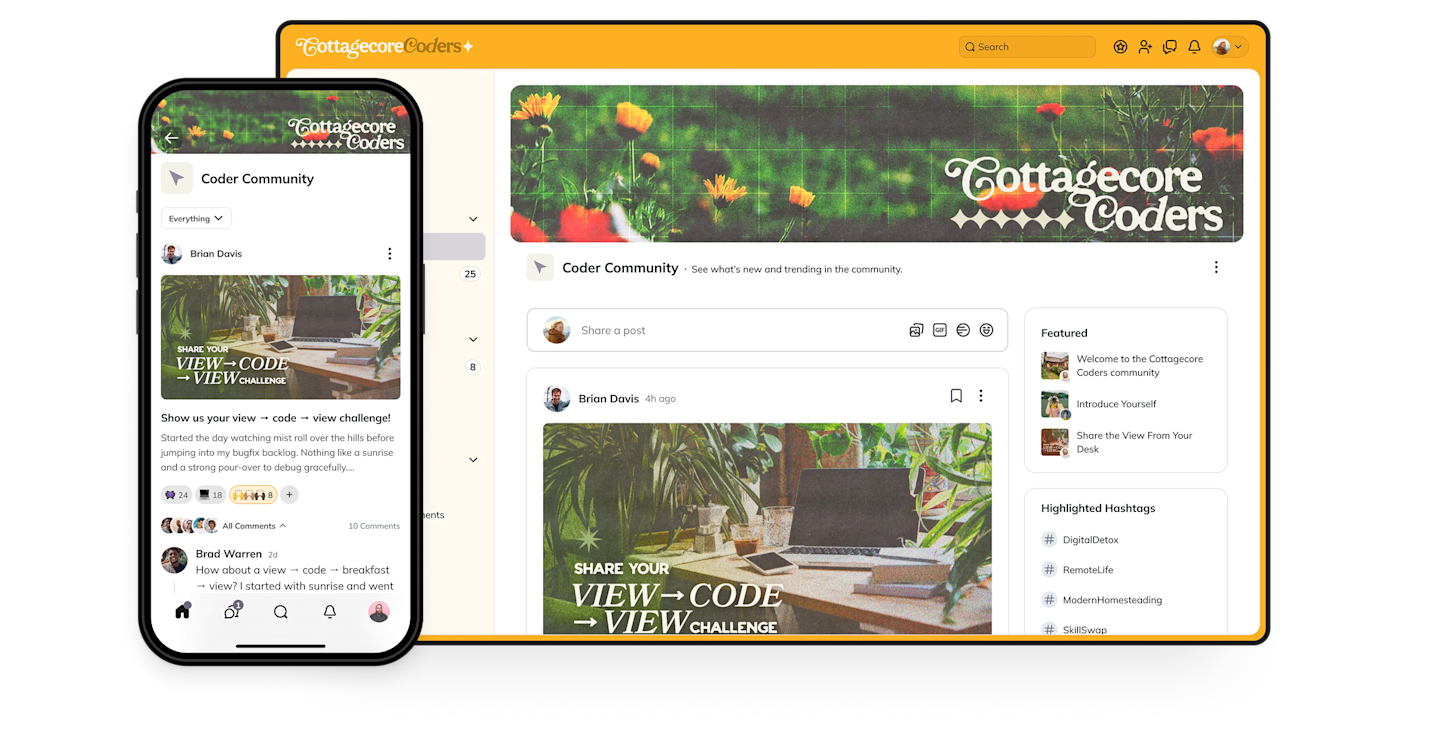
A better business platform: Beyond course options, Mighty lets you build your business selling courses, memberships, and/or live events. Or, add things like group coaching and masterminds. Bundle any or all of these, sell in 135 different currencies, or monetize with token-gating.
Awesome apps: Mighty's apps are well-rated on all devices, (average 4.8 stars in the app stores). Members can not only access your course and build a community, but also watch your livestreams, join events, and more.
Human-focused automation: Mighty Co-Host™ uses AI to create people magic--it boosts human connection; it doesn't replace it. You can automate admin functions: building landing pages, creating profiles, new member welcome sequences, even course outlines, giving you the time to spend on engaging.
Kit integration: On top of notifications in Mighty's course apps, you can also use the Kit integration to easily connect your course and community to your email list--create a newsletter, build automations, sequences, tag members by interest, and get all the power of Kit's awesome platform!
Branded apps: Finally, if you work with Mighty Pro, you can get YOUR course under YOUR brand in the App Store and Google Play Store. We'll talk about that next.
Basically, the word for Mighty Networks is engagement, since you’ve got a ton of options to build long-term value for your members, not to mention offering them new products, events, and subgroups if you choose.
You can try Mighty free for 14 days (no credit card required) to see if it's the right fit!
Mighty Networks features
Full feature set for any type of course: synchronous, asynchronous, or mixed.
Mix and match features like community, livestreaming, events, chat, messaging, resources, and content in rich spaces.
AI tools to automate community and course building (e.g. landing pages, brand identity), plus connect members to each other: profile assist, show similarities, conversation starters, the Infinite Question Generator, and more.
Powerful business engine for selling courses, memberships, coaching, masterminds, events, or bundling any of these in 135 different currencies.
Choose from over ~2,000 software embeds to expand your Mighty Network even further (e.g. Calendly, Loom, Spotify), or use the built-in ConvertKit and Zoom integrations.
Great apps for every device or branded apps.
2. Mighty Pro
Best Thinkific alternative for branded course apps
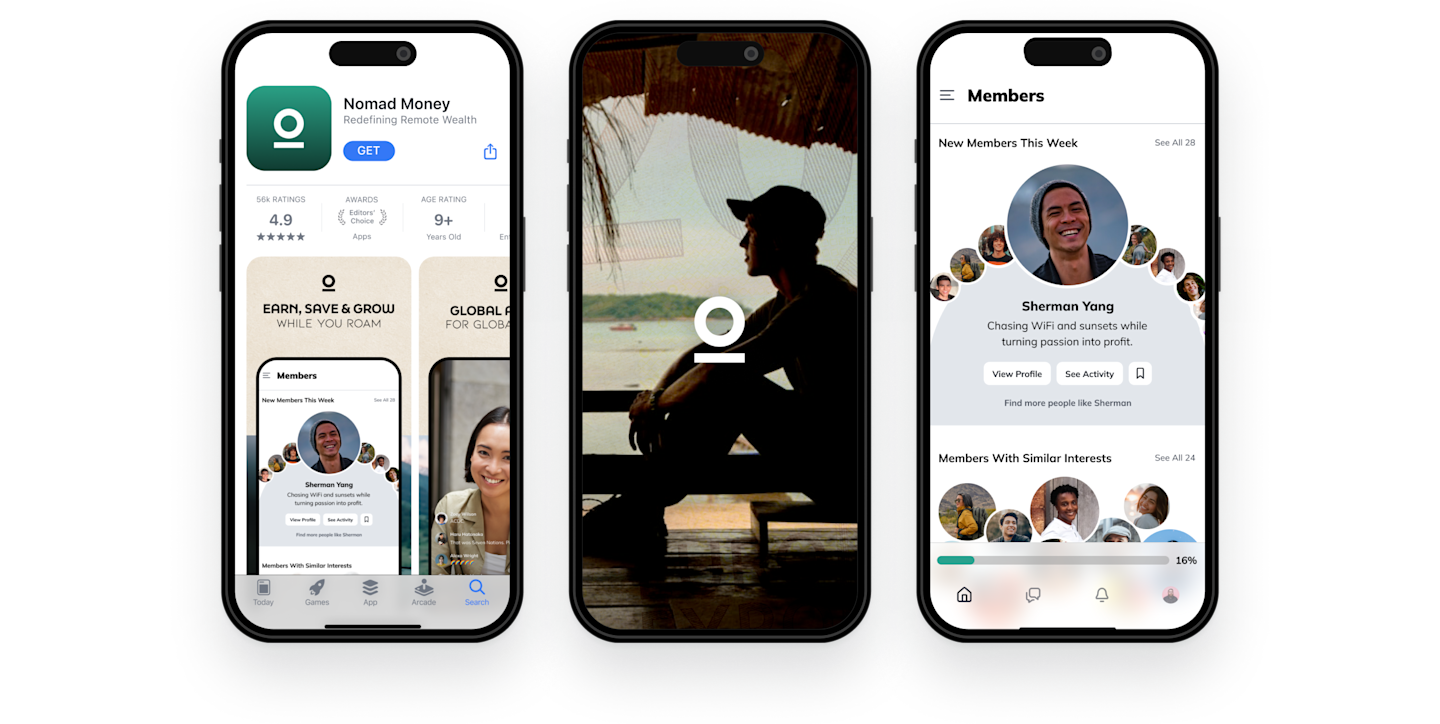
If you want a Thinkific alternative to launch your course on your own branded app, then Mighty Pro is for you. It takes Mighty's top-ranked course and community platform and deploys it under your brand in the App Store and Google Play Store.
Mighty has built more than 400 branded apps for brands and people like Tony Robbins, Jim Kwik, Mel Robbins, TED, Cambridge University, Inc., BODi, nuun, Marie Forleo, and Keap.
Building with Mighty Pro also means:
Your branded apps, complete with push notifications and splash screens.
Proactive updates and Google Play and App Store submissions.
Membership in the Mighty Pro community.
Learn more about Mighty Pro and the different options below.
Mighty Pro features
Beautiful, branded, responsive apps for every device.
YOUR course, notifications, and livestreaming under your brand.
Branding and splash screens, plus proactive upgrades and submissions.
Work with the Mighty Pro team who have launched 400+ apps from the world's top brands and creators.
Options for VIP and strategy support.
3. Kajabi
Best marketing funnels
The third Thinkific alternative is Kajabi. Kajabi is known for its top-of-the-line tools for the business and marketing side of courses and content. It’s a stable, savvy platform for running paid memberships and online courses.
In addition to the ability to host and run online courses with different delivery methods (drip, self-paced, etc) and engaging quizzes and polls, with Kajabi, you get sophisticated marketing tools for email campaigns, welcome flows, weekly updates, and more.
There are optimized marketing landing pages and a feature for creating waitlists or “windows” for purchase. Checkout and payments are clean, easy, and support multiple currencies around the world.
Kajabi is definitely one of the best course platforms for pre-recorded courses. But there are a few downsides to Kajabi for those who want a live course or community.
The good news is that Kajabi recently added a community function: Community 2.0, replacing its old, basic forum feature. It adds a few more community options like meeting rooms and livestreaming.
But the bad news is, Kajabi 2.0 is on a different platform and app. Your members need 2 different apps to get courses and community together. That's 2 logons.
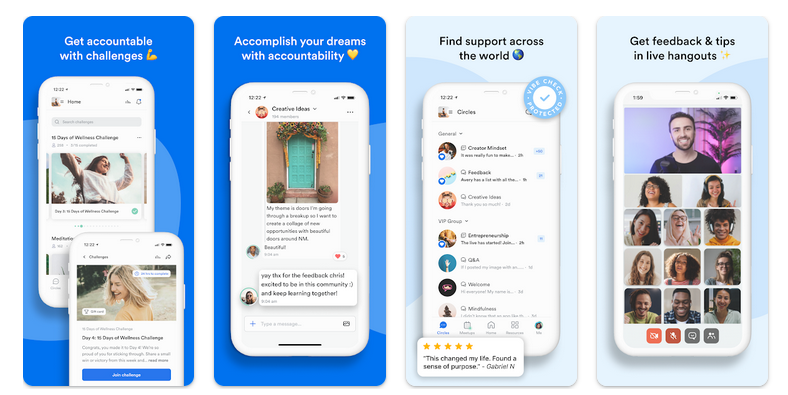
Kajabi has introduced a branded app that competes with Thinkific's offering, but it's extremely basic--although it's the only way Kajabi has to get your course and community on the same app.
Kajabi features
Solid asynchronous course platform with features to drip material, add photos and videos, polls, questions, etc.
Course website builder with templates and customization
Integrated marketing funnels and basic email tool
4. Teachable

Another option that’s an alternative to Thinkific is Teachable.
Teachable has all the features you need to create courses, enroll students, and collect payments. It lets instructors add videos, create quizzes, and even has an affiliate feature you can use to recruit others to sell your course for you–a great way to incentivize your course growth.
Teachable has a clean, powerful LMS for hosting asynchronous course material as well as certification options. And it has both a landing page builder and some integrated marketing tools like up and down-sells, lead magnets, an accelerator challenge, and tracking pixels.
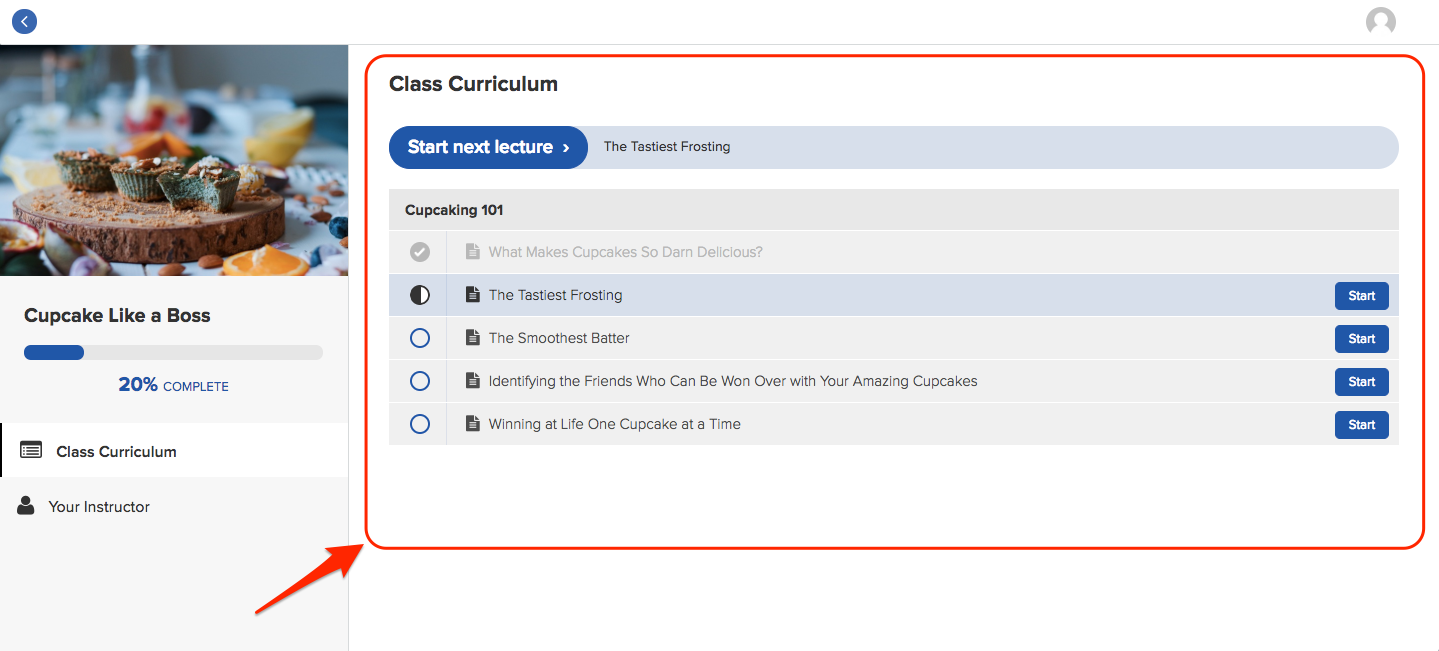
Teachable is good for an asynchronous course that's web-based. And it has a lot of name recognition.
There are a few downsides to Teachable.
It has no Android app. This means many of your students can't access your course on mobile. (And even the Apple app has bad reviews.)
It has no live teaching or community options: you'll notice it's missing livestreaming, discussions, events, and more. It's built for one type of course: pre-recorded.
Teachable's "free" plan requires a 10% transaction fee--which takes a huge chunk out of your revenue.
Teachable features
Easy-to-use LMS for pre-recorded courses
Intuitive page builder for course landing pages and opt-ins
Course marketing tools like affiliate programs, email, cart recovery, up- and down-sells
5. Udemy
Best marketplace option
Another Thinkific alternative we’ll talk about here is Udemy. Udemy is a totally different business model from Thinkific; instead of being a course platform alone, it’s a course marketplace. This can be a blessing or curse depending on what you’re trying to accomplish with your course.
The course platform for Udemy is solid enough--giving you most of the tools to create versatile courses and evaluation options. Udemy has a decent course-building platform, and it lets you offer certificates. You can charge anywhere from $0 - $199 for your Udemy course.
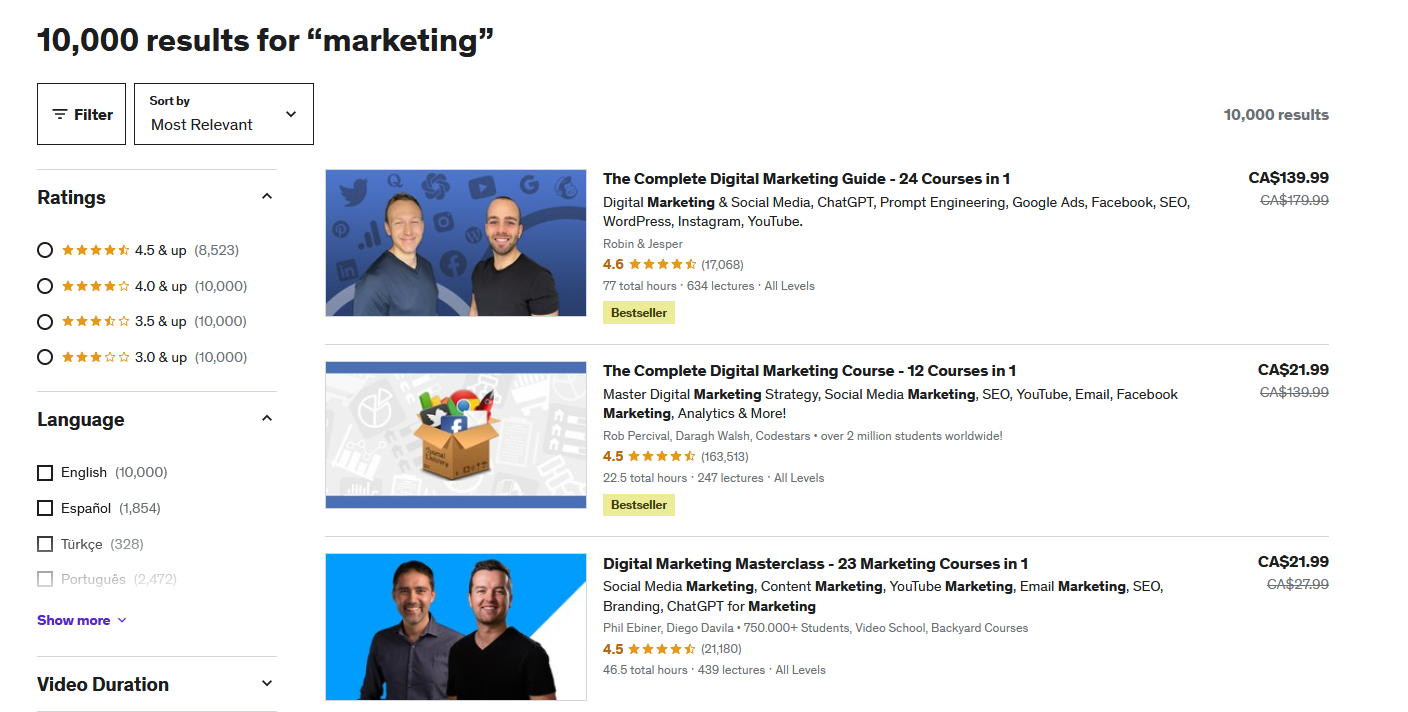
The marketplace means that your course will live alongside thousands of other courses.
It must compete for attention, and you’re limited to their design options.
BUT you have an existing audience to sell to, which can be a plus.
It just depends on your course goals and whether you already have some idea of how to market it to people.
A plus? The Udemy app is awesome, works for every device--and can even stream courses onto Chromecast or Apple TV.
Here are some of the things you should know to assess if Udemy is the right Thinkific alternative for you:
You pay Udemy for customers: Udemy works on a revenue share agreement. If you bring someone to your course through an invite link on one of your channels, Udemy will let you keep 97% of the revenue. If someone finds your course on Udemy and buys it, you’ll keep 37% of the course price.
You don't own your students' info: On Udemy, you don't actually get to build relationships with students. You're building Udemy's brand, these are Udemy students--not yours.
No customization: Udemy courses have to fit their standardized look and feel, so you get next to no customization options.
Udemy features
Course marketplace with a built-in audience
Sell courses from free to $299
Udemy takes care of hosting, design, support, etc. (but they also own the customers and a large chunk of your revenue)
6. Podia

Podia is a course platform that was initially launched for coaches, and it feels a bit like Kajabi. Like Kajabi, Podia's model is based on mixing together marketing features with courses and forums; which can be a useful set of tools.
But Podia's main focus right now is websites--and that's where it shines against Thinkific. If you want a drag-and-drop website builder with multiple pages, templates to build from, and the look and feel of a traditional website + course, Podia could be a good Thinkific alternative.
But by trying to do everything, Podia falls short in a few areas. The course creation mode is functional, but pretty basic. And the "community" is really just a basic forum.
Podia features
Good website builder with drag-and-drop editor and templates
Integrate products and sales into a website (including courses)
Built-in marketing and email tools
7. LearnDash
For those diehard WordPress fans, LearnDash is a plugin that can be used to add a course to a WordPress site.
Any course-builder on WordPress essentially works by building a paywall around a section of your WordPress site. You end up gating some of your content.
LearnDash is a lesson-builder, integrating with the typical Gutenberg WordPress editor and giving you a course editor instead. As far as WordPress solutions, it's fairly intuitive to use. And it can result in a course that merges with your existing website.
Here are a few things you should know when considering LearnDash as a Thinkific alternative:
No monetization: LearnDash needs to be integrated with a monetization tool to actually sell your course.
Difficult customization: Ask anyone who has built on WordPress, and they'll tell you that adding complicated plugins almost always messes something up--and it takes a developer to get the look and feel you want.
No other features: LearnDash is just a course feature, it doesn't bring in the many other benefits for engagement and community that the other options on this list give you.
LearnDash
Course plugin for a wordpress site that's easy to use
A course-builder that feels like Gutenberg
Add badges, certificates, and quizzes.
8. Skillshare
Alternative marketplace option
You've probably heard about Skillshare by now. It's a popular course marketplace platform, like Udemy. It has a better reputation than Udemy for certain subjects--especially for creative and design skills. You get a typical-looking course engine, and subscribers can add reviews to courses.
Skillshare gives you a reasonably good course platform to build on if you're looking for exposure.
Skillshare has very little in terms of engagement features, but it does have a cool project feature so that members can upload things they're working on for instructors or class members to see.
But here are a few downsides to Skillshare:
Worst revenue model: Skillshare pays its creators a portion of its revenue, dividing it up by the average course-viewing time you have. Very few creators earn enough to even pay for the work they put into their course.
No control: You've got no control of the engine or getting yourself seen (even the "Staff Picks" are politicized). The result is a marketplace that leaves you clamoring to get seen--and you probably won't.
Not rewarded for bringing your own members: At least if you bring your own students on Udemy, you keep most of the revenue. On Skillshare you still get the same small rev share.
No ownership: As with Udemy, a marketplace means you don't really own your relationship to your members; the platform does.
Skillshare features
Great course marketplace with high brand recognition
The project feature is a cool tool that adds some engagement.
9. WizIQ
Wiz IQ is an LMS tool with flexible course-building options: the ability to launch live or pre-recorded courses. It's often used for higher ed, government, or business training, and as such feels corporate. But it's really powerful, and it comes with useful course-delivery options, adding assignments and tests. It includes tools like breakout rooms, livestreaming, whiteboarding, and messaging.
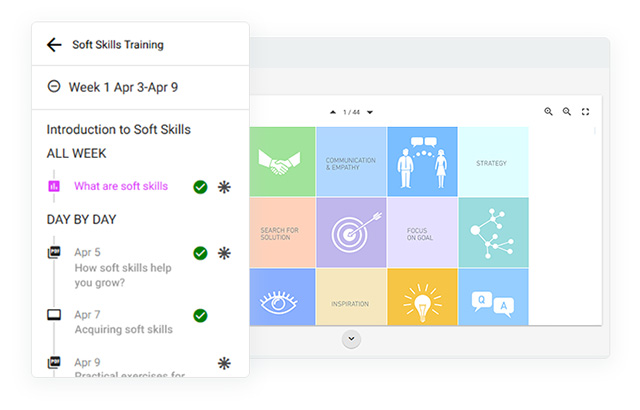
WizIQ has a lot of customization tools, and it can be deployed on white label apps for many different verticals.
WizIQ features
Strong LMS with both asynchronous and synchronous capabilities
Engagement features like whiteboarding, breakout rooms, messaging, and livestreaming
Can be deployed under your own brand
10. Maven
Maven is a course company that takes the total opposite approach to Thinkific. Instead of pre-recorded, asynchronous courses, Maven focuses on cohort courses.
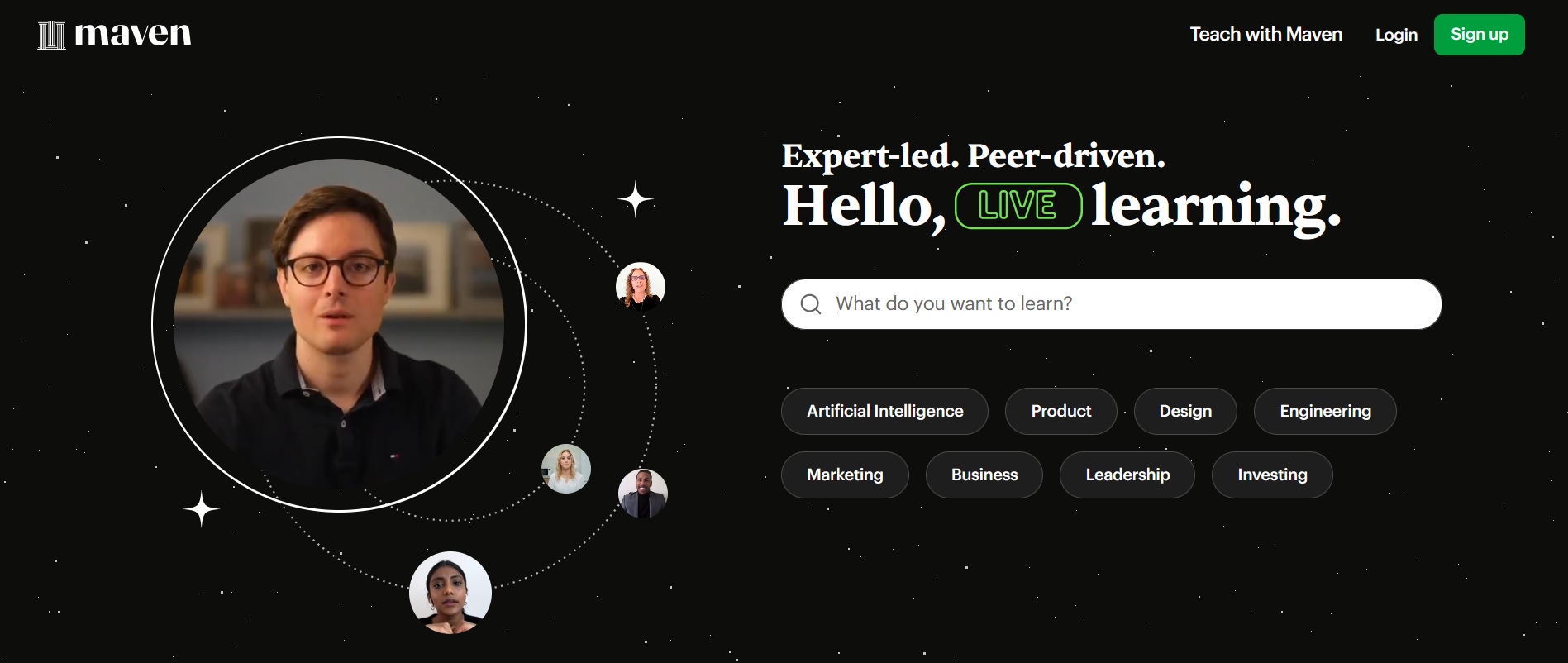
Maven also has a different approach to finding instructors than most other course platforms.
First, they handpick instructors, so you need to apply on their website to be a teacher.
If you're approved, they give you access to a course template library, train you, and give you access to a community of instructors.
If approved to teach a course, you get marketing features like landing pages. And with the power of a cohort course, you teach live to a live audience.
Maven has a directory of courses that members can search through and choose what's interesting to them--so you get help with marketing too.
And Maven often gives you better margins on your courses, you can charge more for live instruction AND the members get better results.
The downside of Maven? It's the same as any other course marketplace. You don't own your relationship with your students--Maven does. So even if you get approved, it doesn't mean you'll control your own course business.
Maven features
Marketplace-type platform for live courses with cultivated teachers
Good tools to engage students and Maven helps promote
Support and training if you're selected as a teacher
11. Circle
Like Mighty Networks, Circle is another community platform with course capability. Circle gives you a set of community-building features, things like discussions, content options, and livestreaming with their premium plans. It also comes with different ways to sell courses and create bundles; and it does best with cohort courses.
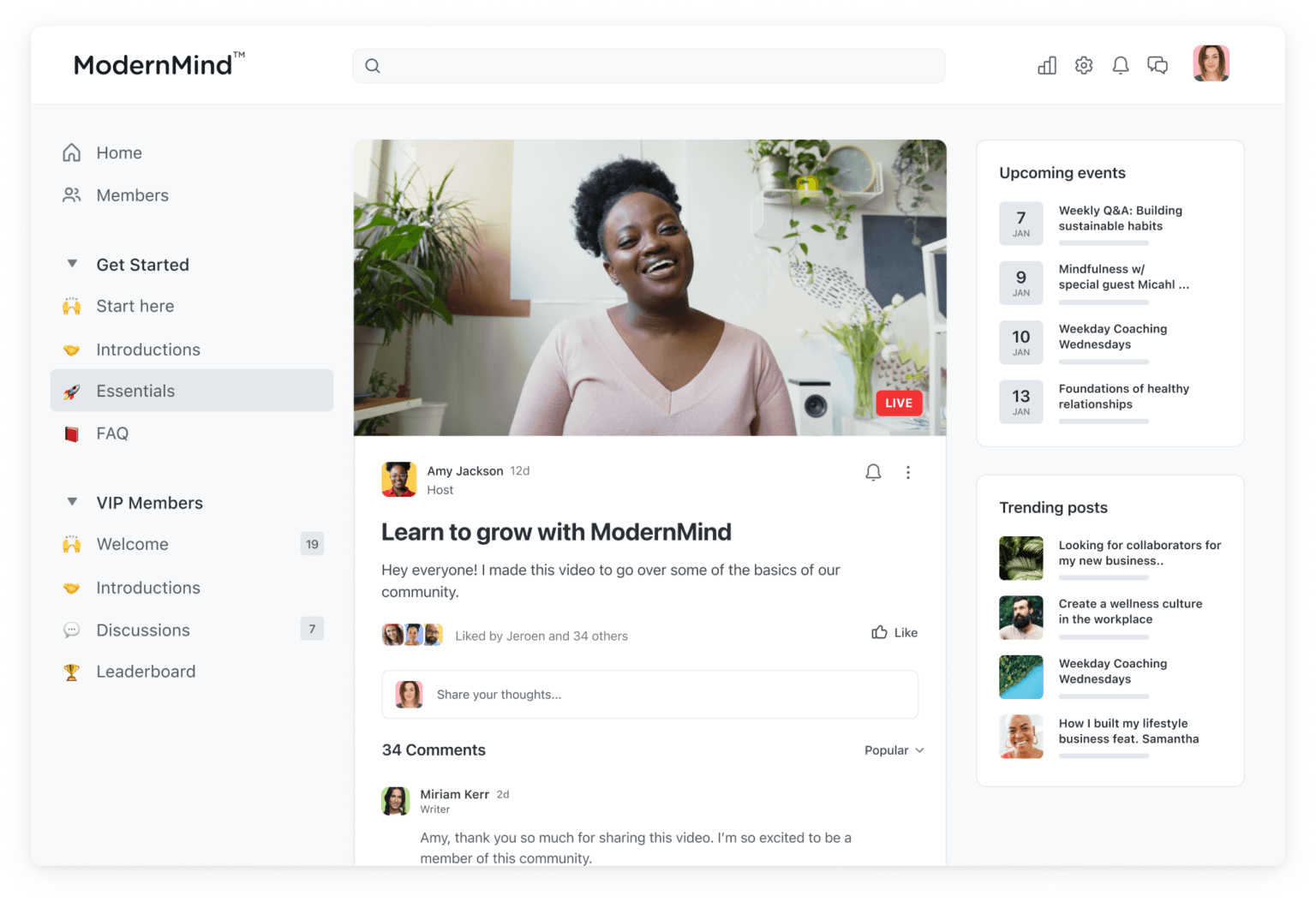
There are a few downsides to Circle's courses. First, Circle requires you to choose what type of Space you want to build--course spaces are one of the options.
Unlike Mighty Networks, you can't mix events, courses, discussions, etc. together. Circle's Spaces are standalone and any extra features exist in different places. This can hurt the UX.
The other downside to Circle is that there are a lot of extra costs. As your membership grows, you need to pay extra for seats, admins, extra Spaces, etc., while these features are all unlimited on a Mighty Network.
Circle features
Good community platform with forum feature and different kinds of spaces
Add a community to a course in a separate space
12. Memberful
For a WordPress plugin that can merge with LearnDash and make your existing blog or website even more course functional, Memberful is an option.
It comes with the functionality to create membership features for a WordPress site--mixed with LearnDash it can give you complete membership and course functionality. It adds content gating, sales, and membership features to a WordPress site.
On this list, Memberful is NOT a course platform. It's an alternative to Thinkific in that it gives you different ways to sell and gate various digital products.
The downsides to Memberful? It basically requires multiple platforms and integrations to do what a lot of the options on this list do natively. Mighty, Kajabi, and Thinkific don't require multiple integrations to sell courses--and that's why Memberful is only for a certain type of user: someone who's determined to use a certain platform without membership features (e.g. LearnDash) and monetize it.
Memberful features
Check-out tool for adding payments and gating to WordPress sites
13. LinkedIn Learning
For a professional with a personal brand and a course, LinkedIn Learning could be a Thinkific alternative. We say could, because there's a similar process to Maven. You need to be approved to teach a course. But if you are, you'll get lots of useful course-building tools to work with.
LinkedIn will pay a flat fee upfront to teach the course, and it can be a decent payment. Then they give out royalties based on watch time.
The benefits to LinkedIn Learning are the same as any other marketplace: lots of users finding your course, working with a trustworthy brand, etc. But there's an added bonus that LinkedIn is a professional platform, so there's also the possibility of spinning your LinkedIn course into things like consulting or speaking.
Unfortunately, the actual revenue still could be quite low from LinkedIn. And like other marketplace platforms, you get no control of your brand AND LinkedIn owns the students.
All these factors mean that--if you can get into LinkedIn--it's got some interesting potential. BUT if you have a strong enough personal brand to get approved to teach on LinkedIn, there's a good chance you could earn more on a self-hosted platform.
LinkedIn Learning features
Great learning platform with global visibility
Up-front payout with watch-time payments after
14. YouTube
Let's round out the list with YouTube. It's a final possible alternative to Thinkific. With 122 million users every day, there are instructors choosing to build their course there.
The advantages to YouTube?
Free and everyone knows it
Large, pre-existing audience
Powerful SEO potential (people can find your videos through search for years after)
Okay, but you probably know there are some disadvantages too.
Here are some of the main disadvantages to YouTube as a Thinkific alternative:
Monetization is hard. There's no real way to sell memberships or course admission. You're giving your stuff away. Which can have some benefits, but it also means your best options for earning natively are through display ads (which are REALLY unprofitable) or affiliates in the posts. Here’s more information on how much you can make per view on YouTube. Otherwise, you need to build a YouTube monetization strategy that relies on another platform.
Competition is fierce. There are lots of creators on YouTube and the algorithm is fickle. There's no way to know that your stuff will get seen.
Subscribers are not members. It's nice to have people follow your channel, but it's not the same as using a membership platform to build deep, meaningful, relationships with your followers. The best YouTube gives you is the comments. And YouTube comments are not community.
YouTube features
Universally recognized and search-engine driven
Free and accessible
Ready to start?
We hope this list has helped you to think through some Thinkific alternatives. We've talked about a lot of different types of course platforms, each with its own advantages and disadvantages. There's something here for everyone.
If you're ready to build a course powered by community, come build with Mighty! Mighty gives you awesome course features that combine with G2's top-rated community platform. And it has way more options for delivering online courses, and building your teaching into bundles. Teach live, pre-record, or mix in course communities and events.
And if you’d like to experience Mighty Networks in action, you can try it free for 14 days! No credit card required.
Ready to start building your community?
Start a free 14-day trial to explore Mighty—no credit card required.
More like this
Join Mighty Community
Learn the principles of Community Design™ (and see them in action) alongside thousands of creators and entrepreneurs. It's free to join!

Online Courses
Creating a Course
Teaching a Course
Course Platforms
Selling a Course
Communities & Memberships
Community Platforms
Managing a Community
Building a Community
Growing a Community
Monetizing a Community
Content Creation
Creators & Entrepreneurs
Monetization
Content Creation
Starting a Business
Website Builders
Creating & Managing a Website
Events
Event Platforms
Hosting & Marketing Events
Branded Apps
Creating a Mobile App
Coaching Apps
Community Apps
Coaching
Mastermind Groups
Starting a Coaching Business
Coaching Platforms
Filter by Category
Online Courses
Communities & Memberships
Creators & Entrepreneurs
Events
Branded Apps
Coaching
Build a $1 Million Community
This free masterclass went viral—sign up to learn why.

























